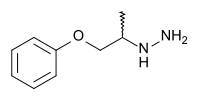Phenoxypropazine
Phenoxypropazine (trade name Drazine) is an irreversible and non-selective monoamine oxidase inhibitor (MAOI) of the hydrazine family. It was introduced as an antidepressant in 1961, but was subsequently withdrawn in 1966 due to hepatotoxicity concerns.[1][2][3][4][5]
 | |
| Clinical data | |
|---|---|
| Routes of administration | Oral |
| ATC code |
|
| Legal status | |
| Legal status |
|
| Identifiers | |
IUPAC name
| |
| CAS Number | |
| PubChem CID | |
| ChemSpider | |
| UNII | |
| ChEMBL | |
| CompTox Dashboard (EPA) | |
| Chemical and physical data | |
| Formula | C9H14N2O |
| Molar mass | 166.22 g/mol g·mol−1 |
See also
References
- LEAHY MR, ROSE JT, PLOWMAN R (April 1963). "A preliminary study of phenoxypropazine in the treatment of depression". The American Journal of Psychiatry. 119: 986–7. doi:10.1176/ajp.119.10.986. PMID 13928824.
- IMLAH NW (May 1963). "Preliminary report on phenoxypropazine". The American Journal of Psychiatry. 119: 1091–2. doi:10.1176/ajp.119.11.1091. PMID 13956423.
- ROSE JT, LEAHY MR, PLOWMAN R (October 1963). "A comparison of phenoxypropazine and amitriptyline in depression". The American Journal of Psychiatry. 120: 393–5. doi:10.1176/ajp.120.4.393. PMID 14069469.
- ROSE JT (March 1964). "Phenoxypropazine and chlordiazepoxide in depression". The American Journal of Psychiatry. 120: 899–900. doi:10.1176/ajp.120.9.899. PMID 14129290.
- MCWHINNEY IR, MORRELL DC (January 1965). "Treatment of mild endogenous depression with a monoamine oxidase inhibitor: a controlled trial in general practice". The Journal of the College of General Practitioners. 9: 95–9. PMC 1878242. PMID 14254271.
This article is issued from
Wikipedia.
The text is licensed under Creative
Commons - Attribution - Sharealike.
Additional terms may apply for the media files.